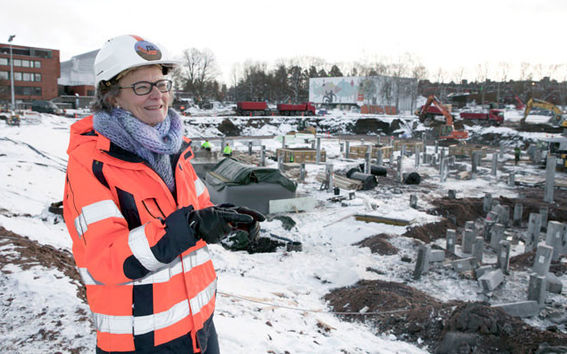High demand for experts in geotechnical engineering

Geotechnical engineering is studied and taught at the Department of Civil and Structural Engineering. Professor Leena Korkiala-Tanttu says that the bachelor's degree programme provides students with a broad competence base to build on. Specialisation is possible in the master's programme.
- Students have been satisfied with the previous degree programme, and I wish that this satisfaction will continue once the new programme begins, Korkiala-Tanttu says.
The new Master's programme in Geoengineering is scheduled to begin in autumn 2016, and students should be able to complete the new programme in two years, which is faster than before.
- The schedule will be more intense, which will be challenging for both students and teachers. The pace will be so fast that working while studying will become more difficult.
The master's programme will provide students with the skills needed in engineering and research positions as well as on worksites.
- Most of the graduates find a job within design, contracting, construction, or the material industry. Only a relatively small number continues as researchers. Foreigners are often more keen on a research career than Finns, Korkiala-Tanttu says.
Mathematical and physical models
Leena Korkiala-Tanttu, Professor of Practice (Geotechnical Engineering) specialises in the geotechnics of infrastructure, such as roads and railways. She is also an experienced researcher of nuclear waste disposal.
Korkiala-Tanttu has worked in the geotechnical engineering field for thirty years and has experience from both the business and the research world. Many things have changed during this time.
The basic theories used in soil mechanics are still valid, but researchers and engineers now also use numerical modelling methods.
- Current mathematical models can be used to simulate the complex behaviour of soil layers in a much more accurate way than before. However, modelling also requires numerous, time consuming laboratory experiments, which is why the better simulations is unfortunately often used to demanding practical cases.
Korkiala-Tanttu is expecting that in the future statistical methods will be taken into use in practical applications. These methods will make it easier to manage the uncertainties caused by the varying properties of soils.
Taking the environment into account
Today, weak soils are generally reinforced using different stabilising techniques that involve adding binders to the soil. Vertical drainage has almost been forgotten.
- Vertical drainage is an inexpensive and environmentally friendly method for reinforcing soil. However, it requires a longer settlement period than stabilising, which does not seem to match the needs of today's fast-paced contracting projects.
The need to pay more attention to environmental matters has increased the use of stabilising in geotechnical engineering projects. Instead of lime and cement, industry by-products such as ash and slag are now often used in stabilising.
The use of steel pipe piling has increased in foundation engineering. Among the most recent developments in the field are small micropiles that can be used for purposes such as creating foundations for houses, noise walls aso.
Desposal of nuclear waste in bedrock caves
Korkiala-Tanttu is one of the four professors working in the computational modelling of rock, soils and structures research group. In addition to two professors in geotechnical engineering, the group includes a professor of rock engineering, a professor of engineering geology, a professor of computational structural engineering and , researchers, doctoral candidates and master students..
Many members of the research group are somehow involved in research projects examining nuclear waste repositories. One of the research subjects is the short- and long-term behaviour of clays used to backfill rock spaces and tunnels.
A total of thirteen doctoral dissertations are currently being prepared by the members of the geoengineering research group. Three of these dissertations discuss nuclear waste repositories, two focus on the pavement structures of roads, and eight examine other subjects.
Contact information;
Professor Leena Korkiala-Tanttu, [email protected]
Read more news

Get to know us: Associate Professor Maria Sammalkorpi
Sammalkorpi received her doctorate from Helsinki University of Technology 2004. After her defence, she has worked as a researcher at the Universities of Princeton, Yale and Aalto.
Aalto computer scientists in ICML 2024
Computer scientists in ICML 2024
Getting bacteria into line
Physicists use magnetic fields to manipulate bacterial behaviour